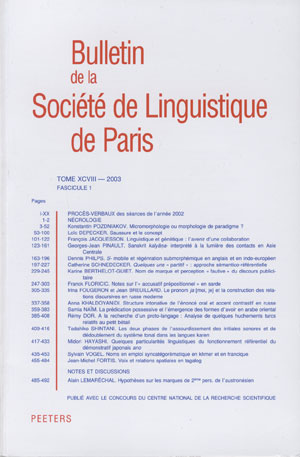 previous article in this issue previous article in this issue | next article in this issue  |

Preview first page |
Document Details : Title: Le continuum linguistique et la relation entre un invariant et ses variantes Author(s): SEILER, Hansjakob Journal: Bulletin de la Société de Linguistique de Paris Volume: 105 Issue: 1 Date: 2010 Pages: 7-33 DOI: 10.2143/BSL.105.1.2062492 Abstract : En linguistique comme en langage courant, le terme de continuum est souvent compris comme dénotant un principe de structuration très général et applicable aux domaines les plus divers. Par différence, le présent travail s’efforce de resserrer le domaine du continuum à plusieurs égards: (a) Il prend comme matière de base les continua étudiés dans le cadre des recherches universalistes de l’auteur et des membres du groupe UNITYP. (b) Il prend son départ dans les continua du niveau de la comparaison des langues, niveau plus riche en observables par rapport au niveau conceptuel «supérieur» qui représente l’abstraction maximale; par rapport aussi au niveau «inférieur» des langues particulières qui présentent des continua partiels et souvent troublés par des faits de la diachronie. (c) Parmi les continua comparatifs, appelés dimensions, on se concentrera sur la convergence de cinq d’entre eux, qui ont été décrits de façon approfondie dans nos travaux antérieurs. Les items ordonnancés de façon continue présupposent un dénominateur commun. Nous interprétons cela comme la relation entre un invariant et ses variantes. A première vue, les deux semblent se présupposer mutuellement, c.-à-d. de façon circulaire. Cependant, il y intervient un aspect sui generis qui consiste précisément dans les propriétés du continuum. Elles s’enchaînent de façon consécutive en reproduisant ainsi un parcours bidirectionnel au long de certaines stations entre un départ et un terme. C’est cet aspect relevé au niveau comparatif qui nous permettra d’apprécier le continuum au niveau conceptuel et d’en déterminer ses traits définitoires. Cet aspect fonctionnera d’autre part comme standard vis-à-vis des continua au niveau des langues particulières en décrivant certains déplacements ou fusions dus aux changements linguistiques. Continuum in linguistics is often understood as a general structuring principle workable in many different domains. In contradistinction to this, the present work purports to establish a clearly defined domain of the linguistic continuum by limiting it in several ways: (a) It takes as its original material the continua described within the framework developed by the author and the members of the UNITYP group. (b) It concentrates on the phenomenology of continua on the level of language comparison. This level presents a greater spectrum of observable phenomena than the «superordinated» level of concepts, which in itself is an abstraction and not accessible to direct observation. We also postpone to later sections phenomena on the level of particular languages, which often represent partial continua or continua disturbed by language change. (c) Among the comparative continua, called «dimensions», we concentrate on five of them, which, according to previous in-depth scrutiny, exhibit a considerable amount of convergence. The ordering of items in a continuous fashion presupposes a common denominator. We interpret this as the mapping of the relation between an invariant and its relevant variants. If we say that any invariant presupposes variation, and variation presupposes an invariant, this is, of course, clearly circular. There is, however, a sui generis aspect, by showing that continuity comes about by interlinked properties of parameters of variation. They follow each other in consecutive ways portraying a bi-directional parcours along a number of variant positions and leading beginning to end and back to the beginning. This parcours of interconnected properties enables us to determine the defining features of the continuum on the conceptual level, the invariant. On the other hand, it acts as a standard for assessing and describing certain displacements and fusions within continua of individual languages. Der Ausdruck Kontinuum wird im umgangssprachlichen Gebrauch und fast ebenso in der Linguistik für ein wie auch immer geartetes strukturelles Prinzip auf sehr verschiedene Phänomene und Bereiche angewendet. Im Gegensatz dazu bemüht sich die vorliegende Arbeit, Bereich und Inhalt des Kontinuumsbegriffes in mehrfacher Weise einzuschränken: (a) Sie nimmt als Ausgangsmaterial diejenigen Kontinua, die im Rahmen des vom Verfasser und den Mitarbeitern der UNITYP-Forschergruppe eingehend beschrieben worden sind. (b) Sie konzentriert sich auf die Erscheinungen von Kontinua auf der Ebene des Sprachvergleichs. Diese bietet ein breiteres Spektrum von Observablen als die «übergeordnete» Ebene der Konzepte, die der direkten Beobachtung nicht zugänglich ist. Sie berücksichtigt bewusst erst in zweiter Linie Phänomene der Einzelsprachen, da diese oft durch Sprachwandel verwischt sind. (c) Unter den Kontinua des Sprachvergleichs, den sog. Dimensionen, wählen wir fünf aus, die aufgrund unserer vorgängigen Beschreibungen ein hohes Mass an Konvergenz zeigen. Die Ordnung von Entitäten in kontinuierlicher Weise setzt die Existenz eines gemeinsamen Nenners voraus. Dies interpretieren wir als die Abbildung der Relation zwischen einem Invarianten und den dazugehörigen Varianten. Zunächst scheint hier Zirkularität zu bestehen: Invariante aufgrund von Varianten, Varianten zu einem Invarianten. Indessen besteht hier auch ein Aspekt sui generis: Das Phänomen der Kontinuität beruht auf der konsekutiven Abfolge von Eigenschaften auf gewissen Parametern der Variation. Ihre Abfolge wird fassbar als zweigerichteter Durchlauf von Positionen und deren Besetzern. Die Beschreibung dieses Durchlaufs auf der Ebene des Sprachvergleichs gibt uns die Möglichkeit, die definierenden Eigenschaften eines Kontinuums auf der konzeptuellen Ebene zu bestimmen. Anderseits bildet der genannte Parcours auch einen Massstab, Kontinua auf der einzelsprachlichen Ebene zu erfassen und die durch Sprachwandel dort festzustellenden Verschiebungen und Fusionen als solche zu würdigen. |
|


